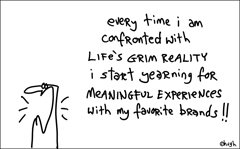
A November 5 article in The New York Times on luxury brands moving to the internet makes an interesting point: that luxury brands are no longer holding on to the notion that selling online means a loss of face to their exclusive tags.
According to the article:
"We've begun to see that the e-commerce shopper is indeed someone who has really quite a level of sophistication, and is older than was once imagined," said Robert Triefus, an executive vice president with Armani Group. "For fashion, that type of consumer is very fundamental."
...
Among other things, Mr. Triefus said, the site opens the brand to consumers who are not near the company's stores. "In a market like America where we've historically only had 10 freestanding stores, this suddenly makes accessible one of our most important collections in a very broad way," he said. "One imagines the virtual store will progressively rise up the charts."
More interestingly, it's the more expensive articles that fly off shelves more quickly.
Basic garments sell comparatively slowly, Mr. Hoffman (Brendan Hoffman, president of Neiman Marcus Direct, the company's catalog and online division) said, but items like $7,900 Valentino gowns, $5,500 Carolina Herrera jackets and other items "with more camera appeal" sell quickly.
"We've yet to see any limits to what they're willing to pay," he said. Two factors are behind the recent growth, Mr. Hoffman said.
First, many more customers have high-speed Internet connections, allowing them to click more freely through multiple pictures of an item and zoom in on shots of fabrics and colors. Mr. Hoffman noted that until 18 months ago, most of his business came during working hours on weekdays. Now much of it comes "on weekends and after 8 p.m., once the kids are in bed," he said.
However, The Business of Fashion has an interesting take on the online trend. Says Imran Amed:
The article goes on to trot out the same old case studies and growth figures of Net-a-Porter and Yoox, and highlights how so many major brands are now moving online, but it fails to really dive into the issue of where do luxury ecommerce retailers go next. Apart from a cursory mention of new features on the Saks.com site, it glosses over the most interesting question of all: where could all of this take luxury in the years to come?
One thing is for sure. We have already seen luxury companies engage in a great land grab for the best retail spaces in the world's international cities over the past decade. Now that most luxury companies are moving online, the next race will be to to make the experience of shopping online the most satisfying, most special, most interactive, and most personalised -- while still respecting the simplicity and ease-of-use (beware the trap of Boo.com!) that makes online shopping convenient.
I'd say he's completely bang on.
Image courtesy: NYT

1 comment:
The way people shop online is already changing - there are lots of social shopping sites, for instance, where users can share favorites and meet people with similar tastes.
Online message boards and things like Style Diary have also made a difference - they let you share your daily ensemble with the world in a much broader way (you're not just limited to your immediate community).
Also, search engines like 3Luxe (http://www.3luxe.com) are helping people tailor their online shopping efforts, particularly for luxury goods - instead of getting thousands of results, you only get the very best 3 items in each category.
Getting to my point, I think that the future of luxury shopping on the net will be much more interactive than it's previously been, and not necessarily controlled solely by the companies and brands - outside websites and communities are going to be involved.
Post a Comment